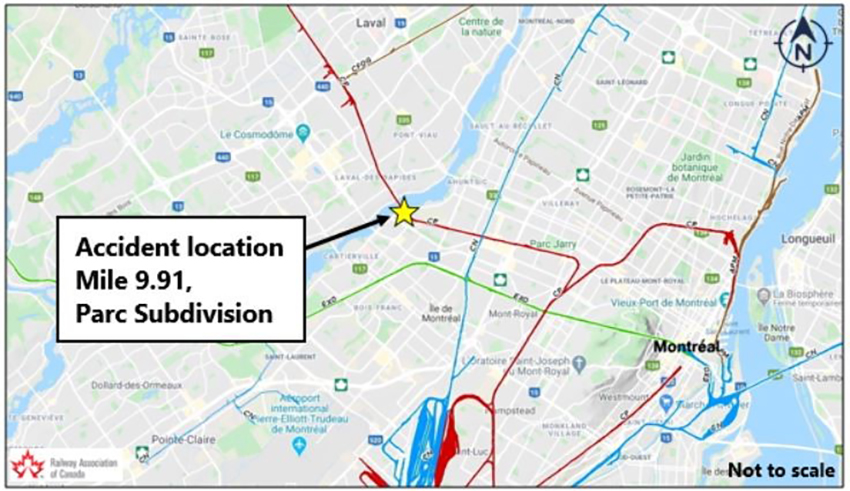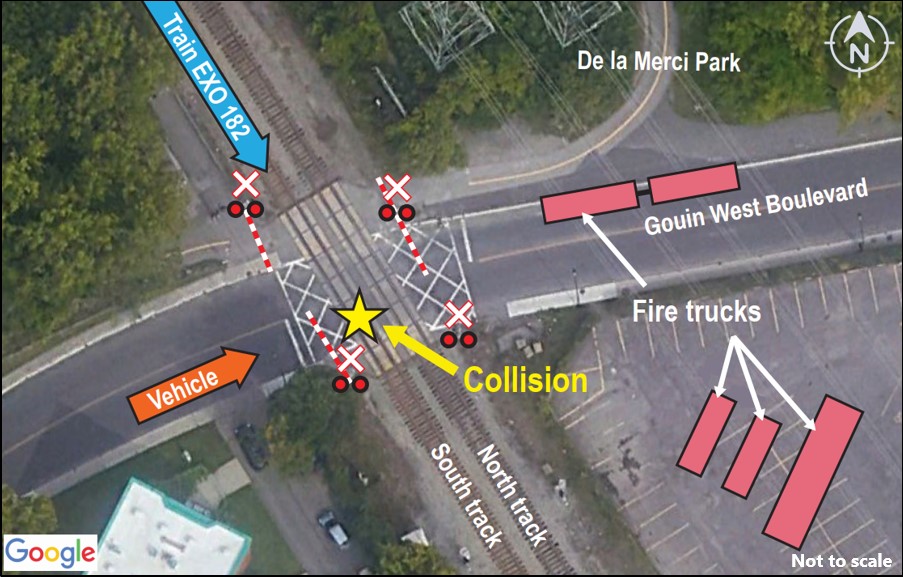Crossing collision
Réseau de transport métropolitain
Commuter train EXO 182
Mile 9.91, Canadian Pacific Railway Parc Subdivision
Montréal, Quebec, Ahuntsic-Cartierville borough
The Transportation Safety Board of Canada (TSB) investigated this occurrence for the purpose of advancing transportation safety. It is not the function of the Board to assign fault or determine civil or criminal liability. This report is not created for use in the context of legal, disciplinary or other proceedings. See Ownership and use of content. Masculine pronouns and position titles may be used to signify all genders to comply with the Canadian Transportation Accident Investigation and Safety Board Act (S.C. 1989, c. 3).
The occurrence
On 18 February 2020, commuter train EXO 182 on the exo2 Saint-Jérôme line of the Réseau de transport métropolitain (RTM), operating as exo, was travelling between Saint-Jérôme Station, Quebec, at Mile 33.2 of the Canadian Pacific Railway (CP) Parc Subdivision, and Parc Station, at Mile 6.0 of the Parc Subdivision, in Montréal, Quebec. This scheduled train, consisting of lead locomotive EXO 1322 and 6 Bombardier 3000 multilevel passenger cars, was carrying 232 passengers. The train weighed approximately 510 tons and was about 575 feet long.
The train crew consisted of a locomotive engineer (LE) and a conductor.Footnote 1 Both crew members were qualified for their respective positions, met rest and fitness requirements, and were familiar with the territory.
The train, travelling east on the south main track, crossed the bridge at Perry Island and was heading toward Bois-de-Boulogne Station (Mile 8.90). At approximately 0922,Footnote 2 the train approached the public crossing at Gouin West Boulevard (Mile 9.91) at a speed of 44 mph (Figure 1).
Seeing a car stopped on the crossing, the locomotive engineer sounded the locomotive horn at 0923:19 and, around 3 seconds later, initiated an emergency brake application. The train began to slow down and, 4 seconds later, struck the car at 42 mph, before coming to a stop approximately 200 m further on. The lead locomotive headlights were on full power, the ditch lights were activated, and the locomotive bell was ringing.Footnote 3
The occurrence was captured by a surveillance camera at a business near the crossing. The camera footage showed that, when the flashing lights and bells of the automatic warning devices at the crossing were activated, a car travelling east on Gouin West Boulevard entered onto the railway right-of-way and stopped near the crossing gate. That car was followed by another vehicle that stopped behind it. The crossing gate then lowered onto the roof of the car. The car then moved forward and stopped on the south track, and the crossing gate continued to lower behind the car.
During this time, the passenger tried unsuccessfully to intervene with the driver, asking him several times to move forward to clear the tracks, while the vehicle behind the car blew its horn.
A uniformed firefighter who was taking part in a search and rescue exerciseFootnote 4 near the scene of the occurrence was on the sidewalk on the southeast side of the crossing. When he saw the car stop on the south track, the firefighter moved to the middle of the pavement waving his arms to indicate to the car’s driver to move forward to clear the crossing. The car then reversed about 1 m and, after stopping for approximately 7 seconds, moved forward to stop on the tracks just before being hit by the train.
After the collision, several firefighters who were taking part in the search and rescue exercise assisted the occupants of the car. The 2 occupants of the vehicle received serious injuries and were transported to the hospital by ambulance. The driver died of his injuries shortly after arriving at the hospital. No one on the train was injured.
At the time of the occurrence, the sky was overcast and the temperature was −10 °C. It was snowing heavily and visibility was reduced. About 5 cm of snow covered the painted marks on the pavement and the tracks. The wind was blowing from the northwest at about 15 km/h.
Site examination
The collision occurred at a public crossing equipped with automatic warning devices (flashing lights, bells, and gates) that were activated. The car was hit behind the left centre pillar and was pushed about 25 m southeast of the crossing. The train remained on the tracks and did not sustain any mechanical damage. No fuel was spilled (Figure 2).
No damage was observed to the tracks or the automatic warning devices. Rail and road traffic were interrupted in the area. The passengers stayed on board the train until they were taken to Parc station by bus around noon. The train left the scene at approximately 1440.
Information on the crossing
Gouin West Boulevard is a 2-lane asphalt road in an urban area. Between Letellier and Poincaré streets, the road traverses a level crossing at an angle of approximately 15 degrees relative to the perpendicular. For a driver coming from the west, the road has a slight curve to the right at this location. There are sidewalks on both sides of the road and a bike path to the north. The speed limit for road vehicles is 30 km/h in this area.
During the week, the daily traffic on either of the double tracks of the Parc subdivision consists of 30 exo commuter trains and 4 freight trains. They go through many crossings on their routes, including the crossing at Gouin West Boulevard. On average, just over 9300 road vehicles go through this crossing every day.
The authorized train speedFootnote 5 at this crossing is 40 mph for freight trains and 45 mph for passenger trains on the south track (the furthest west).
The crossing was compliant with the applicable Transport Canada standards.Footnote 6 It was equipped with automatic warning devices in each of the four quadrants, and all of them were functional at the time of the occurrence. The warning devices were activated automatically when a train approached at least 23 seconds before the crossing was occupied. The gates began lowering 9 seconds after the automatic warning devices were activated, and they completed their descent 9 seconds later.
Information on the car
Following the occurrence, a mechanical assessment was conducted on the condition of the car.Footnote 7 The car, a 2016 4-door sedan with front-wheel drive and automatic transmission, had winter tires in good condition on all 4 wheels. The safety belts in both front seats had been stretched, indicating that they were being worn at the time of the occurrence. The side curtain airbags on the left side of the vehicle were deployed.
No mechanical defects were identified.
Information on the driver of the car
The driver of the car, a man in his 70s, was taking a driving test and was accompanied by an evaluator from the Société de l’assurance automobile du Québec (SAAQ).
The driver’s licence had been suspended by the SAAQ in November 2018 following a report by a healthcare professional that the driver was unfit to operate a motor vehicle. The healthcare professional had determined that the driver’s lower binocular visual fieldFootnote 8 was significantly reduced.
Following a request by the driver to review the file, the SAAQ received confirmation that the driver’s vision had remained stable. The next step was to determine, via a road test, whether the driver had developed compensatory abilities that would enable him to drive safely. It was during this test that the collision occurred.
Visual and auditory clutter
When driving an automobile, drivers must constantly focus on many elements in their visual field, with most relevant information being in the lower visual field. When there are many elements that are close together, there is the possibility of visual clutter, which reduces the driver’s visual field and requires more scanning to be able to fully assess the situation. This can increase the driver’s reaction time, which is amplified in poor light conditions.Footnote 9
In this occurrence, the driver was subjected to multiple stimuli in his lower visual field. These included the flashing lights and moving gates of the automatic warning devices at the crossing, the presence of fire trucks and other vehicles, and the indications being given by the firefighter.
At the same time, the driver’s attention was also being drawn by auditory stimuli from several sources: the horn of the vehicle behind the car, the bells at the crossing, and the locomotive’s whistle. In addition, the SAAQ evaluator kept telling the driver that he had to move forward to clear the tracks.
All these stimuli likely confused the driver. Moreover, poor visibility and the driver’s reduced lower binocular visual field may have increased his reaction time.
Other collisions at public crossings
Between 01 February 2010 and the time of this occurrence, the TSB identified 147 collisionsFootnote 10 with injuries in Canada involving trains and road vehicles at public crossings equipped with automatic warning devices.
Of the 147 collisions:
- 73 occurred at crossings equipped with flashing lights and bells;
- 74 occurred at crossings equipped with flashing lights, bells and gates;
- 59, or 40%, occurred in the winter (December to March), of which:
- 26 occurred at crossings equipped with flashing lights and bells;
- 33 occurred at crossings equipped with flashing, lights, bells and gates.
A total of 189 people were injured in those collisions, 88 of whom were fatally injured.
Safety message
Each year, many people are seriously or fatally injured in collisions between trains and road vehicles at public crossings equipped with automatic warning devices. Approximately 40% of these collisions occur in the winter months (from December to March). When approaching crossings, drivers of road vehicles should take weather and road conditions into consideration in order to be able to stop safely when the automatic warning devices are activated.
Drivers who inadvertently stop on a crossing when the automatic warning devices are activated must immediately clear the track to avoid a possible collision, even if the gates are lowered and are blocking the road. The gates are designed to detach when struck by a vehicle so that the vehicle can clear the tracks.
This report concludes the Transportation Safety Board of Canada’s investigation into this occurrence. The Board authorized the release of this report on . It was officially released on .

